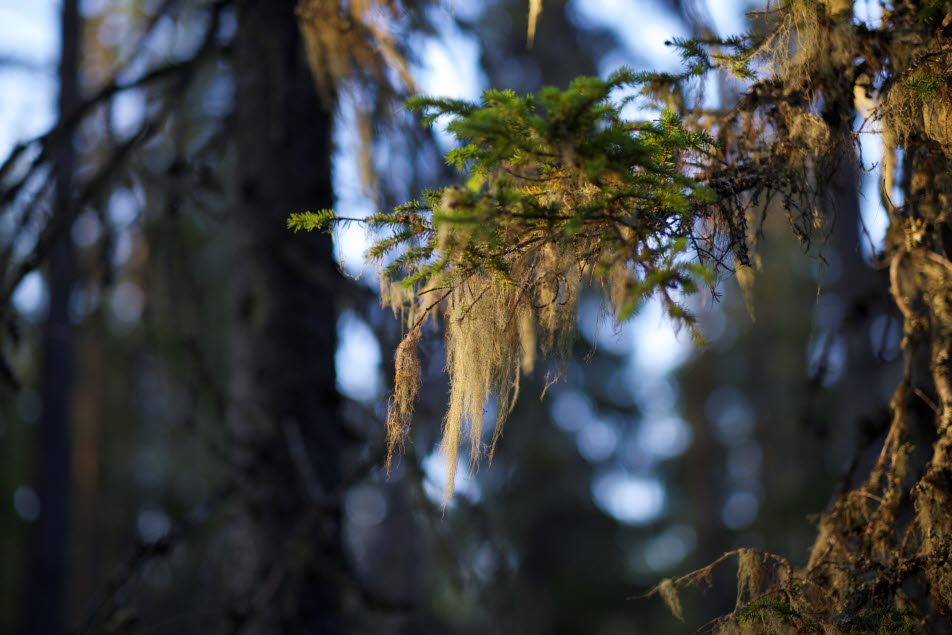Holmen’s Knowledge forests are large areas of forest with high conservation value that we are opening up to gather and share knowledge about forestry, biodiversity and growth.
Biodiversity
Holmen works actively with nature conservation, which aims to make a positive contribution to biodiversity in our forests. We strive for high and profitable growth while all naturally occurring species should be able to survive in the forest landscape.
Active measures for viable forests
Historically, biodiversity was not a priority issue in Swedish forestry, but over the past 30 years, the focus has shifted. The development has been rapid and the knowledge of how we can create healthy ecosystems and at the same time increase growth in the forest is constantly increasing.
Holmen's forest strategy strives for high and profitable growth while ensuring that all naturally occurring species can survive in the Swedish forest landscape. Of Holmen's 1.3 million hectares of land, almost 1.2 million hectares are forest land, while the other areas consist mainly of water. mountains and marshes.
Nature conservation set-asides are the parts of our forest land that are exempt from forestry as they have large or unique values that should be preserved.
Distribution of our forest holdings

Forest impediments are forests where the trees grow very slowly due to a lack of nutrients or water, for example on rocky outcrops and bogs. No forestry is carried out in these areas.
In our active forestry, we take great account of both natural and cultural values. Since forest-dwelling species are dependent on different environments for their survival, coarse deciduous trees, dead trees and unusually old trees are saved through our general consideration.
We also protect valuable protection zones around lakes, watercourses, marshes and agricultural landscapes. These environments are often very species-rich as a result of varying humidity, light and soil types, while plants and animals from the forest mix with those from the water, marsh or open landscape
Read more here:
Good conditions for biodiversity in the Nordic Region
A biodiversity index from the UK's Natural History Museum models human impact on nature and estimates what proportion of the original number of species and habitats remains.
The desired level of biodiversity in an area is at least 90 per cent, which is to be regarded as a limit value that the biodiversity in an area should not be below. Sweden and Finland are the two most forested countries in Europe, both with about 70 percent forest land, a large part of which is actively managed. According to the Biodiversity Index, there are also two countries with good conditions for functioning ecosystems, both with an index of just over 95 percent.
This can be compared to the global average of 77 percent, significantly lower than the 90 percent that is considered sustainable. The index also shows that the conditions for biodiversity in Sweden have improved over the past 50 years. For more information about the Biodiversity Index, see page 119 of Holmen's Annual Report 2023 (pdf).
Biodiversity Index 2023

Development of the Biodiversity Index 1970-2023
Biodiversity indicators

In our work for viable forests, we have identified shortcomings in certain habitats. In order to monitor and develop these environments, we have developed four indicators, all of which have a clear link to biodiversity in the forest:
• Area of older forest
• Area of older forest with high conservation values
• Volume of dead wood per hectare
• Timber storage of coarse deciduous trees per hectare
Since the measurements began, the development of these indicators has been strongly positive in Sweden, which shows that our work with environmental considerations is effective.
Read more about ecological land planning
Positive development for biodiversity in Sweden's forests
How Swedish forests are to be managed is regulated in the Forestry Act, among other things. Forestry legislation has a long history in Sweden and as early as 1903 the first more modern forestry law was introduced with requirements for regrowth, i.e. that all forest that is harvested must be reforested. Over the years, there has been a great deal of development in knowledge, and methods for creating healthy and viable forests are constantly being developed.
Since the current Forestry Act was introduced in Sweden in 1993, production goals and environmental goals have been equal. The preservation of natural and environmental values thus became as important as the forest's production values. The requirements for consideration include, among other things , the size of clearcuts, that individual trees and dead wood are left at harvest and that considerate biotopes and valuable cultural environments must be protected.
With a production cycle in the forest of almost a hundred years, changes do not happen overnight, but several indicators show a clear positive development since the law was introduced. The amount of deciduous trees has increased by more than 20 per cent and the proportion of coarse deciduous trees has more than doubled since 1993. The area of old forest and the amount of hard dead wood have also more than doubled in the last 30 years.
Area of old forest (160+ years)

Volume of standing timber, large broadleaves


